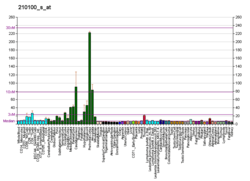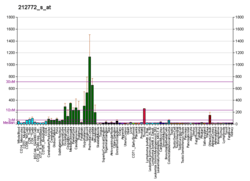ABCA2
ATP-binding cassette sub-family A member 2 is a protein that in humans is encoded by the ABCA2 gene.[5][6]
The membrane-associated protein encoded by this gene is a member of the superfamily of ATP-binding cassette (ABC) transporters. ABC proteins transport various molecules across extra- and intracellular membranes. ABC genes are divided into seven distinct subfamilies (ABC1, MDR/TAP, MRP, ALD, OABP, GCN20, White). This protein is a member of the ABC1 subfamily. Members of the ABC1 subfamily comprise the only major ABC subfamily found exclusively in multicellular eukaryotes. This protein is highly expressed in brain tissue and may play a role in macrophage lipid metabolism and neural development. Two transcript variants encoding different isoforms have been found for this gene.[6]
See also
References
- GRCh38: Ensembl release 89: ENSG00000107331 - Ensembl, May 2017
- GRCm38: Ensembl release 89: ENSMUSG00000026944 - Ensembl, May 2017
- "Human PubMed Reference:". National Center for Biotechnology Information, U.S. National Library of Medicine.
- "Mouse PubMed Reference:". National Center for Biotechnology Information, U.S. National Library of Medicine.
- Luciani MF, Denizot F, Savary S, Mattei MG, Chimini G (Oct 1994). "Cloning of two novel ABC transporters mapping on human chromosome 9". Genomics. 21 (1): 150–9. doi:10.1006/geno.1994.1237. PMID 8088782.
- "Entrez Gene: ABCA2 ATP-binding cassette, sub-family A (ABC1), member 2".
Further reading
- Schmitz G, Kaminski WE (2002). "ABCA2: a candidate regulator of neural transmembrane lipid transport". Cell. Mol. Life Sci. 59 (8): 1285–95. doi:10.1007/s00018-002-8508-5. PMID 12363033.
- Adams MD, Dubnick M, Kerlavage AR, et al. (1992). "Sequence identification of 2,375 human brain genes". Nature. 355 (6361): 632–4. doi:10.1038/355632a0. PMID 1538749.
- Allikmets R, Gerrard B, Glavac D, et al. (1995). "Characterization and mapping of three new mammalian ATP-binding transporter genes from an EST database". Mamm. Genome. 6 (2): 114–7. doi:10.1007/BF00303254. PMID 7766993.
- Kikuno R, Nagase T, Ishikawa K, et al. (1999). "Prediction of the coding sequences of unidentified human genes. XIV. The complete sequences of 100 new cDNA clones from brain which code for large proteins in vitro". DNA Res. 6 (3): 197–205. doi:10.1093/dnares/6.3.197. PMID 10470851.
- Klucken J, Büchler C, Orsó E, et al. (2000). "ABCG1 (ABC8), the human homolog of the Drosophila white gene, is a regulator of macrophage cholesterol and phospholipid transport". Proc. Natl. Acad. Sci. U.S.A. 97 (2): 817–22. doi:10.1073/pnas.97.2.817. PMC 15414. PMID 10639163.
- Zhao LX, Zhou CJ, Tanaka A, et al. (2001). "Cloning, characterization and tissue distribution of the rat ATP-binding cassette (ABC) transporter ABC2/ABCA2". Biochem. J. 350 (3): 865–72. doi:10.1042/0264-6021:3500865. PMC 1221321. PMID 10970803.
- Kaminski WE, Piehler A, Püllmann K, et al. (2001). "Complete coding sequence, promoter region, and genomic structure of the human ABCA2 gene and evidence for sterol-dependent regulation in macrophages". Biochem. Biophys. Res. Commun. 281 (1): 249–58. doi:10.1006/bbrc.2001.4305. PMID 11178988.
- Vulevic B, Chen Z, Boyd JT, et al. (2001). "Cloning and characterization of human adenosine 5'-triphosphate-binding cassette, sub-family A, transporter 2 (ABCA2)". Cancer Res. 61 (8): 3339–47. PMID 11309290.
- Wistow G, Bernstein SL, Wyatt MK, et al. (2002). "Expressed sequence tag analysis of adult human lens for the NEIBank Project: over 2000 non-redundant transcripts, novel genes and splice variants". Mol. Vis. 8: 171–84. PMID 12107413.
- Nakayama M, Kikuno R, Ohara O (2003). "Protein-protein interactions between large proteins: two-hybrid screening using a functionally classified library composed of long cDNAs". Genome Res. 12 (11): 1773–84. doi:10.1101/gr.406902. PMC 187542. PMID 12421765.
- Strausberg RL, Feingold EA, Grouse LH, et al. (2003). "Generation and initial analysis of more than 15,000 full-length human and mouse cDNA sequences". Proc. Natl. Acad. Sci. U.S.A. 99 (26): 16899–903. doi:10.1073/pnas.242603899. PMC 139241. PMID 12477932.
- Davis W, Chen ZJ, Ile KE, Tew KD (2003). "Reciprocal regulation of expression of the human adenosine 5'-triphosphate binding cassette, sub-family A, transporter 2 (ABCA2) promoter by the early growth response-1 (EGR-1) and Sp-family transcription factors". Nucleic Acids Res. 31 (3): 1097–107. doi:10.1093/nar/gkg192. PMC 149212. PMID 12560508.
- Ile KE, Davis W, Boyd JT, et al. (2005). "Identification of a novel first exon of the human ABCA2 transporter gene encoding a unique N-terminus". Biochim. Biophys. Acta. 1678 (1): 22–32. doi:10.1016/j.bbaexp.2004.01.007. PMID 15093135.
- Chen ZJ, Vulevic B, Ile KE, et al. (2005). "Association of ABCA2 expression with determinants of Alzheimer's disease". FASEB J. 18 (10): 1129–31. doi:10.1096/fj.03-1490fje. PMID 15155565.
- Davis W, Boyd JT, Ile KE, Tew KD (2004). "Human ATP-binding cassette transporter-2 (ABCA2) positively regulates low-density lipoprotein receptor expression and negatively regulates cholesterol esterification in Chinese hamster ovary cells". Biochim. Biophys. Acta. 1683 (1–3): 89–100. doi:10.1016/j.bbalip.2004.04.009. PMID 15238223.
- Homma K, Kikuno RF, Nagase T, et al. (2004). "Alternative splice variants encoding unstable protein domains exist in the human brain". J. Mol. Biol. 343 (5): 1207–20. doi:10.1016/j.jmb.2004.09.028. PMID 15491607.
- Macé S, Cousin E, Ricard S, et al. (2005). "ABCA2 is a strong genetic risk factor for early-onset Alzheimer's disease". Neurobiol. Dis. 18 (1): 119–25. doi:10.1016/j.nbd.2004.09.011. PMID 15649702.
- Wang Y, Yamada K, Tanaka Y, et al. (2005). "Expression of ABCA2 protein in human vestibular schwannoma and peripheral nerve". J. Neurol. Sci. 232 (1–2): 59–63. doi:10.1016/j.jns.2005.01.016. PMID 15850583.
External links
- ABCA2+protein,+human at the US National Library of Medicine Medical Subject Headings (MeSH)
- ABCA2 human gene location in the UCSC Genome Browser.
- ABCA2 human gene details in the UCSC Genome Browser.
This article incorporates text from the United States National Library of Medicine, which is in the public domain.





